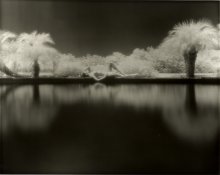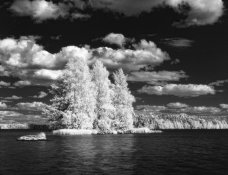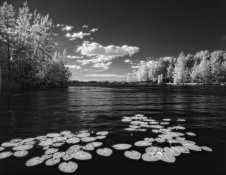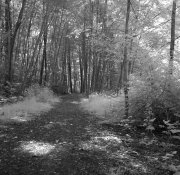Dan Dozer
Subscriber
- Joined
- Dec 10, 2004
- Messages
- 411
- Format
- Large Format
So I tried out infrared film for the first time and the attached print is my first effort. This was just my first check print - not an attempt at a final print by any means. Metered at ASA of 6 and exposed with a #87 filter. Exposure time was 30 seconds (about plus 5 stops) in mid day sun with no clouds or haze in the sky. Film developed in PMK Pyro in trays.
Negative is pretty low in contrast. This print is done with a #4 filter on Ilford MCMulitgrade FB Warm Tone paper.
One thing that I'm wondering about is that there is some blotchyness/streaking in the sky on the left side of the image and some lightness in the water lower left. Have any of you used this film before and is it unpredictable regarding areas of no detail to have minor problems like this? I don't know if it is something related to the film or my processing (in PMK Pyro). Perhaps this fllm doesn't like Pyro very much. I'm interested in anyone's thoughts/recommendations towards developer if in fact this problem is due to the PMK Pyro that I used.
I love the look that Infrared film gives. Image looks very eerie looking as expected. Note that the print looks much better than the scan image.
Negative is pretty low in contrast. This print is done with a #4 filter on Ilford MCMulitgrade FB Warm Tone paper.
One thing that I'm wondering about is that there is some blotchyness/streaking in the sky on the left side of the image and some lightness in the water lower left. Have any of you used this film before and is it unpredictable regarding areas of no detail to have minor problems like this? I don't know if it is something related to the film or my processing (in PMK Pyro). Perhaps this fllm doesn't like Pyro very much. I'm interested in anyone's thoughts/recommendations towards developer if in fact this problem is due to the PMK Pyro that I used.
I love the look that Infrared film gives. Image looks very eerie looking as expected. Note that the print looks much better than the scan image.














 The filters I was able to find at what I was willing to spend were 720 and 760 nm, so that's what I bought. The #87 stuff might be OK with the EFKE film, but I think its too deep for the Rollei, especially the 87C. I'm not positive, but I think the 720 nm filters are targeted at folks playing with their bit zappers.
The filters I was able to find at what I was willing to spend were 720 and 760 nm, so that's what I bought. The #87 stuff might be OK with the EFKE film, but I think its too deep for the Rollei, especially the 87C. I'm not positive, but I think the 720 nm filters are targeted at folks playing with their bit zappers.

